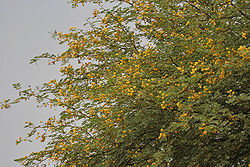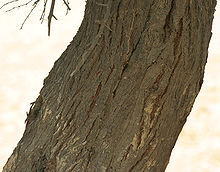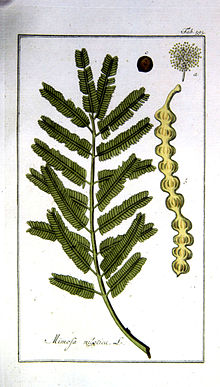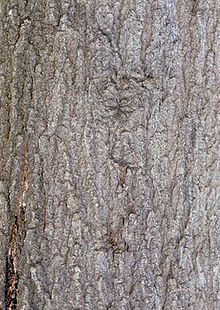- Acacia nilotica
-
Acacia nilotica 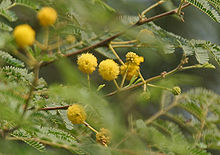
Scientific classification Kingdom: Plantae (unranked): Angiosperms (unranked): Eudicots (unranked): Rosids Order: Fabales Family: Fabaceae Genus: Acacia Species: A. nilotica Binomial name Acacia nilotica
(L.) Willd. ex Delile
Range of Acacia nilotica Synonyms Acacia nilotica (gum arabic tree,[2] babul, Egyptian thorn, Sant tree, Al-sant or prickly acacia;[3] called thorn mimosa in Australia; lekkerruikpeul or scented thorn in South Africa) is a species of Acacia (wattle) native to Africa and the Indian subcontinent. It is also currently an invasive species of significant concern in Australia. For the ongoing reclassification of this and other species historically classified under genus Acacia, see the list of Acacia species.
Contents
Description
Acacia nilotica is a tree 5–20 m high with a dense spheric crown, stems and branches usually dark to black coloured, fissured bark, grey-pinkish slash, exuding a reddish low quality gum. The tree has thin, straight, light, grey spines in axillary pairs, usually in 3 to 12 pairs, 5 to 7.5 cm long in young trees, mature trees commonly without thorns. The leaves are bipinnate, with 3-6 pairs of pinnulae and 10-30 pairs of leaflets each, tomentose, rachis with a gland at the bottom of the last pair of pinnulae. Flowers in globulous heads 1.2-1.5 cm in diameter of a bright golden-yellow color, set up either axillary or whorly on peduncles 2–3 cm long located at the end of the branches. Pods are strongly constricted, hairy, white-grey, thick and softly tomentose. Its seeds number approximately 8000/kg.[4]
Distribution
Acacia nilotica, Scented Thorn Acacia, is native from Egypt, across the Maghreb and Sahel, south to Mozambique and Natal, and east through Arabian Peninsula to Pakistan, India and Burma.[5]
It has become widely naturalised outside its native range including Zanzibar, and Australia. Acacia nilotica is restricted to riverine habitats and seasonally flooded areas within its native range[citation needed] however in its introduced range it is spread by livestock and grows outside riparian areas.[5]
Uses
Forage and fodder
In part of its range smallstock consume the pods and leaves, but elsewhere it is also very popular with cattle. Pods are used as a supplement to poultry rations in India. Dried pods are particularly sought out by animals on rangelands. In India branches are commonly lopped for fodder. Pods are best fed dry as a supplement, not as a green fodder.
Hedges
A. nilotica makes a good protective hedge because of its thorns.[6]
Medicine
A. nilotica may also be used for medicinal purposes, as a demulcent or for conditions such as gonorrhoea, leucorrhoea, diarrhea, dysentery or diabetes. It is styptic and astringent. In Siddha medicine, the gum is used to consolidate otherwise watery semen.[7]
Bark
According to Hartwell, African Zulu take bark for cough. It acts as an astringent and it is used to treat diarrhea, dysentery, and leprosy.
Twigs
In most parts of Indian sub-continent, thin twigs are chewed and used as a toothbrush.
Bark and root
Maasai are intoxicated by the bark and root decoction, said to impart courage, even aphrodisia, and the root is said to cure impotence.
Bark or gum
In West Africa, the bark or gum is used to treat indurations of liver and spleen, condylomas, and excess flesh.[citation needed] Sap or bark, leaves, and young pods are strongly astringent due to tannin, and are chewed in Senegal as an antiscorbutic.
Leaves
The bruised leaves are poulticed and used to treat ulcers.
Resin
In Lebanon, the resin is mixed with orange-flower infusion for typhoid convalescence.
Root
The Chipi use the root for tuberculosis. In Tonga, the root is used to treat tuberculosis.
Seed pods
Egyptian Nubians believe that diabetics may eat unlimited carbohydrates as long as they also consume powdered pods.
Wood
In Italian Africa, the wood is used to treat smallpox. In Ethiopia, certain parts of the tree are used as a lactagogue.
Lumber
The tree's wood is "very durable if water-seasoned" and its uses include tool handles and lumber for boats.[6] The wood has a density of about 1170 kg/m³.[8]
Propagation
There are 5000-16000 seeds/kg.[9]
Subspecies
- Acacia nilotica subsp. adstringens (Schum. & Thonn.) Brenan[8]
- Acacia nilotica subsp. cupressiformis
- Acacia nilotica subsp. hemispherica
- Acacia nilotica subsp. indica (Benth.) Brenan[8]
- Acacia nilotica subsp. kraussiana (Benth.) Brenan[8]
- Vatke) Brenan[8]
- Acacia nilotica subsp. tomentosa (Benth.) Brenan[8][10]
See also
References
- ^ ILDIS LegumeWeb
- ^ http://www.itis.gov/servlet/SingleRpt/SingleRpt?search_topic=TSN&search_value=182086
- ^ http://dictionary.infoplease.com/babul http://www.merriam-webster.com/dictionary/babul http://www.worldagroforestry.org/Sea/Products/AFDbases/AF/asp/SpeciesInfo.asp?SpID=81
- ^ Handbook on Seeds of Dry-zone Acacias FAO
- ^ a b http://www.weeds.crc.org.au/documents/wmg_prickly_acacia.pdf
- ^ a b Google Books Select Extra-tropical Plants Readily Eligible for Industrial Culture Or Naturalization By Ferdinand von Mueller
- ^ Dr. J. Raamachandran, "HERBS OF SIDDHA MEDICINES - The First 3D Book on Herbs"
- ^ a b c d e f g FAO
- ^ Tropical Forages
- ^ USDA Germplasm Resources Information Network (GRIN)
External links
Sources of condensed tannins Areca catechu seed (arecatannins) | Broad bean (Vicia faba) | Grape (Vitis vinifera) | Quebracho wood | Mimosa bark (Acacia mollissima) | Myrtan or black marlock (Eucalyptus redunca)Sources of hydrolysable tannins Chestnut wood | Dhawa (Anogeissus latifolia) | Myrobalan fruit (Terminalia chebula) | Oak wood, bark or acorn cup (Valonea Quercus macrolepis) | Sumac (Tanner's sumach leaves - Rhus coriaria or Chinese gall on Rhus chinensis) | Tara pod (Caesalpinia spinosa)Other sources Alder (Alnus sp) | Avaram (Senna auriculata) | Babul (Acacia nilotica) | Birch (Betula sp) | Larch (Larix sp) | Hemlock (Tsuga sp) | mangrove | Pine (Pinus sp) | Spruce (Picea sp) | Urunday (Myracrodruon urundeuva) | Willow (Salix caprea)Cutch (Acacia catechu)Whole plantProsopis sp. bark and wood (eg Prosopis humilis or Algarrobilla) | Tanoak (Lithocarpus densiflorus) | Tizra heartwood and root (Rhus pentaphylla)Misc Categories:- Acacia
- Drought-tolerant trees
- Medicinal plants
- Ayurvedic medicaments
- Forages
- Flora of Northern Africa
- Flora of East Africa
- Flora of Southern Africa
- Flora of Western Asia
- Trees of the Middle East
- Trees of Africa
- Trees of India
- Flora of Egypt
- Flora of Libya
- Flora of Tunisia
- Flora of Algeria
- Flora of Morocco
- Flora of Senegal
- Flora of Burkina Faso
- Flora of Côte d'Ivoire
- Flora of Ethiopia
- Flora of Somalia
- Flora of Sudan
- Flora of Kenya
- Flora of Tanzania
- Flora of Uganda
- Flora of Ghana
- Flora of Guinea-Bissau
- Flora of Mali
- Flora of Niger
- Flora of Nigeria
- Flora of Togo
- Trees of Angola
- Flora of Malawi
- Flora of Mozambique
- Flora of Yemen
- Flora of Saudi Arabia
- Flora of Zambia
- Flora of Zimbabwe
- Flora of Botswana
- Trees of South Africa
- Flora of Oman
- Trees of Iran
- Flora of Iraq
- Flora of Bangladesh
- Flora of Nepal
- Flora of Pakistan
- Flora of India
- Flora of Sri Lanka
- Flora of Burma
- Invasive plant species in Australia
- Flora naturalised in Australia
Wikimedia Foundation. 2010.

